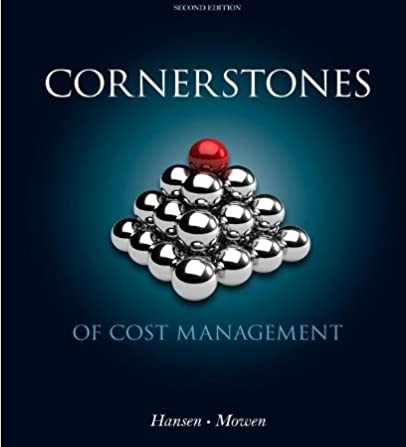
Cornerstones of Cost Management 2nd Edition by Don Hansen ,Maryanne Mowen
Edition 2ISBN: 978-1111824402
Cornerstones of Cost Management 2nd Edition by Don Hansen ,Maryanne Mowen
Edition 2ISBN: 978-1111824402 Exercise 32
Journal Entries, T-Accounts, Cost of Goods Manufactured and Sold
During May, the following transactions were completed and reported by Jerico Company:
a. Materials purchased on account, $60,100.
b. Materials issued to production to fill job-order requisitions: direct materials, $50,000; indirect materials, $8,800.
c. Payroll for the month: direct labor, $75,000; indirect labor, $36,000; administrative, $28,000; sales, $19,000.
d. Depreciation on factory plant and equipment, $10,400.
e. Property taxes on the factory accrued during the month, $1,450.
f. Insurance on the factory expired with a credit to the prepaid insurance account, $6,200.
g. Factory utilities, $5,500.
h. Advertising paid with cash, $7,900.
i. Depreciation on office equipment, $800; on sales vehicles, $1,650.
j. Legal fees incurred but not yet paid for preparation of lease agreements, $750.
k. Overhead is charged to production at a rate of $18 per direct labor hour. Records show 4,000 direct labor hours were worked during the month.
l. Cost of jobs completed during the month, $160,000.
The company also reported the following beginning balances in its inventory accounts:

Required:
1. Prepare journal entries to record the transactions occurring in May.
2. Prepare T-accounts for Materials Inventory, Overhead Control, Work-in-Process Inventory, and Finished Goods Inventory. Post all relevant entries to these accounts.
3. Prepare a statement of cost of goods manufactured.
4. If the overhead variance is all allocated to cost of goods sold, by how much will cost of goods sold decrease or increase?
During May, the following transactions were completed and reported by Jerico Company:
a. Materials purchased on account, $60,100.
b. Materials issued to production to fill job-order requisitions: direct materials, $50,000; indirect materials, $8,800.
c. Payroll for the month: direct labor, $75,000; indirect labor, $36,000; administrative, $28,000; sales, $19,000.
d. Depreciation on factory plant and equipment, $10,400.
e. Property taxes on the factory accrued during the month, $1,450.
f. Insurance on the factory expired with a credit to the prepaid insurance account, $6,200.
g. Factory utilities, $5,500.
h. Advertising paid with cash, $7,900.
i. Depreciation on office equipment, $800; on sales vehicles, $1,650.
j. Legal fees incurred but not yet paid for preparation of lease agreements, $750.
k. Overhead is charged to production at a rate of $18 per direct labor hour. Records show 4,000 direct labor hours were worked during the month.
l. Cost of jobs completed during the month, $160,000.
The company also reported the following beginning balances in its inventory accounts:

Required:
1. Prepare journal entries to record the transactions occurring in May.
2. Prepare T-accounts for Materials Inventory, Overhead Control, Work-in-Process Inventory, and Finished Goods Inventory. Post all relevant entries to these accounts.
3. Prepare a statement of cost of goods manufactured.
4. If the overhead variance is all allocated to cost of goods sold, by how much will cost of goods sold decrease or increase?
Explanation
Journal entry records the financial tran...
Cornerstones of Cost Management 2nd Edition by Don Hansen ,Maryanne Mowen
Why don’t you like this exercise?
Other Minimum 8 character and maximum 255 character
Character 255


